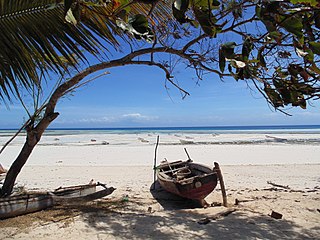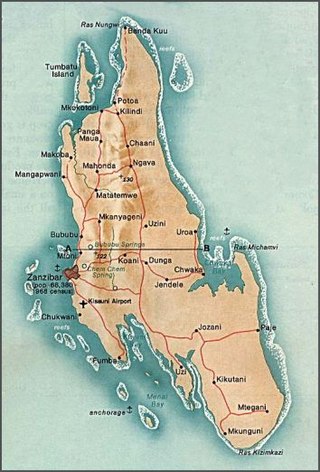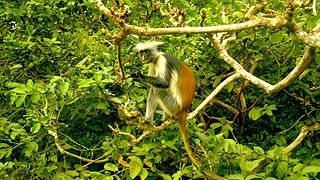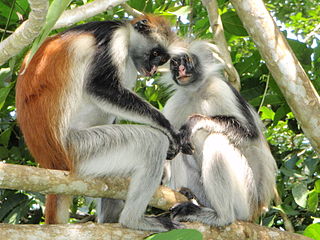Related Research Articles

Unguja South Region, Zanzibar South Region or South Zanzibar Region is one of the 31 regions of Tanzania. The region covers an area of 854 km2 (330 sq mi). The region is comparable in size to the combined land area of the nation state of Kiribati. and the administrative region is located entirely on the island of Zanzibar. Unguja South Region is bordered on three sides to the south by Indian Ocean, northeast by Unguja North Region and northwest by Mjini Magharibi Region. The regional capital is the town of Koani. Besides being known for its Spinner dolphin populations, the region is also home to the oldest mosque in East Africa, the Kizimkazi Mosque and also historic Makunduchi town. The region has the fourth highest HDI in the country, making one of the most developed regions in the country. According to the 2012 census, the region has a total population of 94,504.
Mkokotoni is a city located on the Tanzanian island of Unguja (Zanzibar). The city serves as the capital of the Zanzibar North region. It is 4 kilometres (2.5 mi) west of the village of Kibaoni.

The Zanzibar Archipelago are a group of islands off the coast of mainland Tanzania in the sea of Zanj. The archipelago is also known as the Spice Islands. There are four main islands, three primary islands with permanent human populations, a fourth coral island that serves as an essential breeding ground for seabirds, plus a number of smaller islets that surround them and an isolated tiny islet.

Uzi Island is an island in the south of Zanzibar, connected by causeway to the main island of Unguja. It is located immediately to the south of the main island's Unguja Ukuu ruins. The island is undeveloped and contains few occupants who temporarily dwell there for fishing. Uzi island is six kilometres in length, making it the second largest of the smaller islands which surround Unguja.

Mbweni is a settlement located in Mjini Magharibi Region of the Tanzanian island of Unguja, the main island of Zanzibar. It is located on the central west coast, seven kilometres south of the Zanzibari capital of Stone Town.
Bububu is a town on the Tanzanian island of Unguja, the main island of Zanzibar. It is located on the central west coast, 10 kilometres north of the Zanzibari capital of Stone Town.
Chukwani is a suburb on the Tanzanian island of Unguja, part of Zanzibar. It is located in the west of the island, south of Mbweni, Zanzibar, and not far from Abeid Amani Karume International Airport
Chuini is a village on the Tanzanian island of Unguja, part of Zanzibar. It is located in the west of the island, 12 kilometres north of the capital, Zanzibar City.
Chwaka is a town on the Tanzanian island of Unguja, part of Zanzibar. It is located on the east coast of the island, due east of the capital Zanzibar City, on the coast of Chwaka Bay close to the edge of Jozani-Chwaka Bay National Park.

Jambiani is a group of villages on the Tanzanian island of Unguja, part of Zanzibar. It is located on the southeast coast between Paje and Makunduchi. Jambiani has a strong seaweed culture with many farms dotting the coastline and employing 15,000 locals, mainly women. Most seaweed that is farmed here is sold to the Zanea Seaweeds Ltd company and distributed around the globe. The Island of Zanzibar produces around 11,000 tons of seaweed each year, a large amount of this coming from Jambiani sources.
Fumba is a village on the Tanzanian island of Unguja, part of Zanzibar. It is located in the southwest of the island, at the end of the Fumba Peninsula, and overlooks Menai Bay in Mjini Mgaharibi Region.

Jozani is a village located in Kusini District of Unguja South Region of the Tanzanian island of Unguja. It is located in the southeast of the island, 3.1 miles south of Chwaka Bay, close to the edge of the Jozani-Chwaka Bay National Park. It is primarily a farming community of about 800 people. located 21.7 miles south-east of Zanzibar Town off the road leading to Paje, Zanzibar. It is easily reached by public buses 309 and 310, by chartered taxi or as an organized tour from Zanzibar Town. These tours are often in combination with dolphin observation in Kizimkazi, one of Zanzibar's oldest settlements with a tiny 12th century mosque open to public. The main road on the island, connecting the west and east coasts of Zanzibar, also connects to Jozani. Besides public bus routes 9, 10 and 13, you can also get here from Zanzibar Town by dala-dala number 309, 310, 324, and 326. Jozani is a small and rural village, situated in the innermost part of the Pete Inlet Bay, immediately south of the Jozani Chwaka Bay National Park. It is one of six rural villages surrounding the park. Residents here depend to a large degree on the Jozani Forest as a source of firewood, hunting, building resources, farming, fishing, and more. The village also operates ecotourism in the Jozani Forest and has constructed a 0.6 mile boardwalk through the mangroves at the southern road entrance into the national park. Many villagers work as authorized guides for tours in the southern tip of Jozani Forest.
Kae is not a village, but the beach of Michamvi village on the Tanzanian island of Unguja, part of Zanzibar. It is one of two villages located in the east of the island at the northern tip of Michamvi Peninsula. It lies on the shore of Chwaka Bay, immediately to the west of the village of Pingwe.
Kibaoni is a village on the Tanzanian island of Unguja, part of Zanzibar. It is located in the central north of the island, four kilometres to the east of Mkokotoni.
Chwaka Bay is a large indentation in the central east coast of the Tanzanian island of Unguja - the largest island of the Zanzibar Archipelago. The bay contains several small islands, and the towns of Chwaka and Kae are situated on its coast.
Kibweni is a village on the Tanzanian island of Unguja, part of Zanzibar in the continent of Africa. It is located on the west coast, five kilometres to the north of the capital, Zanzibar City, on the road to Bububu and Chuini.
Kitogani is a village on the Tanzanian island of Unguja, part of Zanzibar in the continent of Africa. It is located in the southeast of the island, two kilometres south of Jozani.
Mahonda is a village on the Tanzanian island of Unguja, part of Zanzibar. It is located in the northeast of the island, seven kilometres to the west of Kinyasini and 20 kilometres northeast of the capital, Zanzibar City.

Uroa, sometimes spelled Urowa, is a small, rural coastal village on central eastern parts of Unguja in Tanzania. It is situated in the Chwaka Constituency in the Unguja South Region. It is located in the Uroa Bay, approximately halfway between the villages of Kiwengwa and Chwaka; 21.7 miles (34.9 km) north of Zanzibar Town. It is located 5.6 miles (9.0 km) north of Chwaka and 7.1 miles (11.4 km) south of Kiwengwa. Uroans mostly live on fishing and seaweed farming; tourism is also developing in the area, although to a lesser extent than on the south-eastern coast around Jambiani. It is a small and centerless village with resorts on the southern and northern side of its bay. It is home to only six stores and is recognized as a traditional, slow-paced, and spread-out village. Uroa Village stretches in a narrow, long line from south to north along the coastline, appropriately named Uroa Beach. The elevation of the town is only 3.2 feet on average. Its economy has traditionally relied on fishing and seaweed collecting, but has since 2008 experienced a growth in tourist accommodation. In addition, recent years have also seen an increase in governmental jobs such as health workers, administrators and teachers. New sources of income have contributed to an increased median income for Uroans, however, the income is fairly unequally distributed. For instance, the monthly income for seaweed farmers represent only U.S. $7 per farmer, while Uroans working in the tourist industry makes U.S. $65 on average per month.

The wildlife of Zanzibar consists of terrestrial and marine flora and fauna in the archipelago of Zanzibar, an autonomous region of Tanzania. Its floral vegetation is categorized among the coastal forests of eastern Africa as the Southern Zanzibar-Inhambane coastal forest mosaic and the Northern Zanzibar-Inhambane coastal forest mosaic. Its faunal species are mostly small animals, birds, and butterflies.
References
- Finke, J. (2006) The Rough Guide to Zanzibar (2nd edition). New York: Rough Guides.